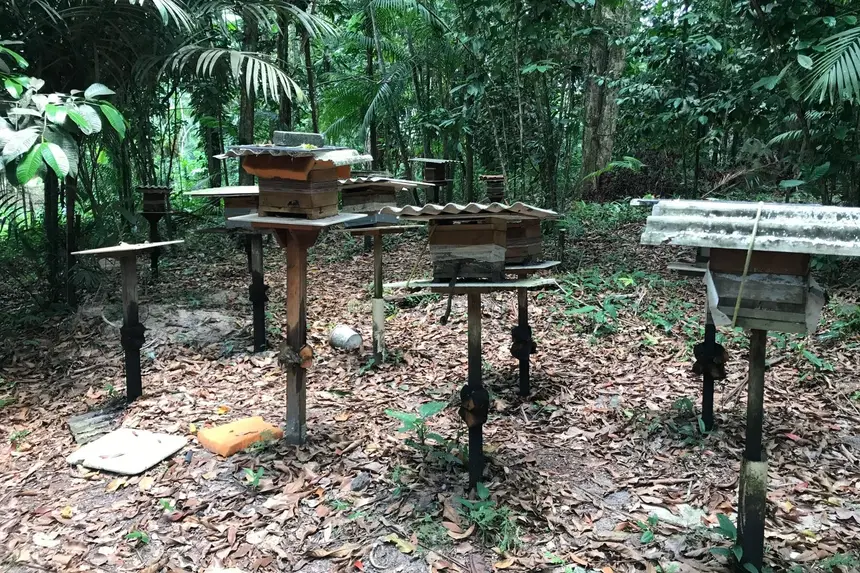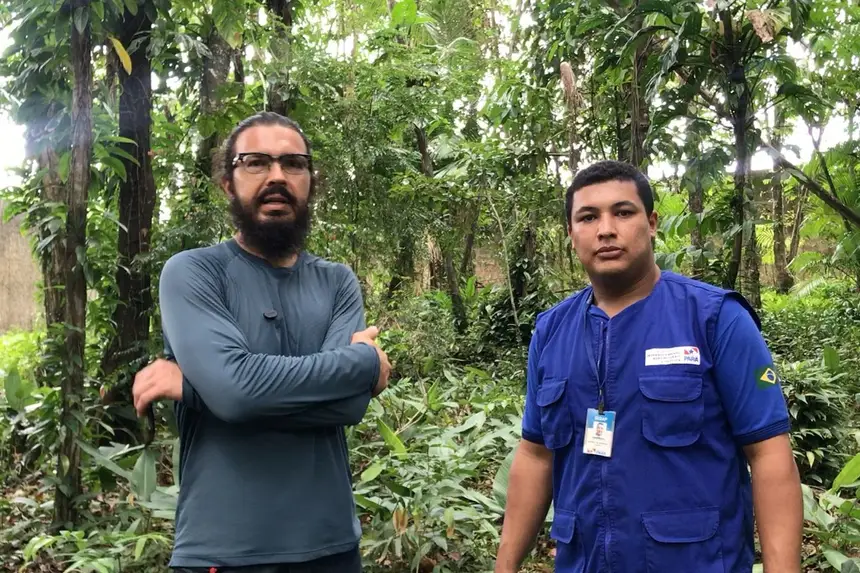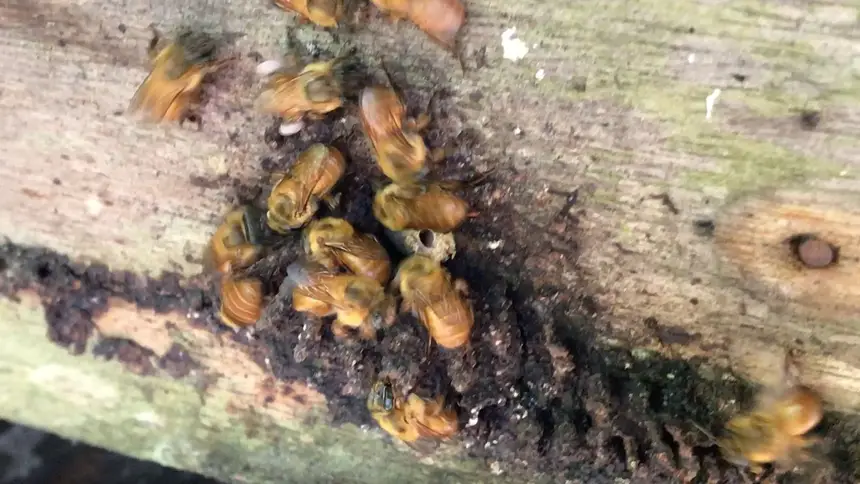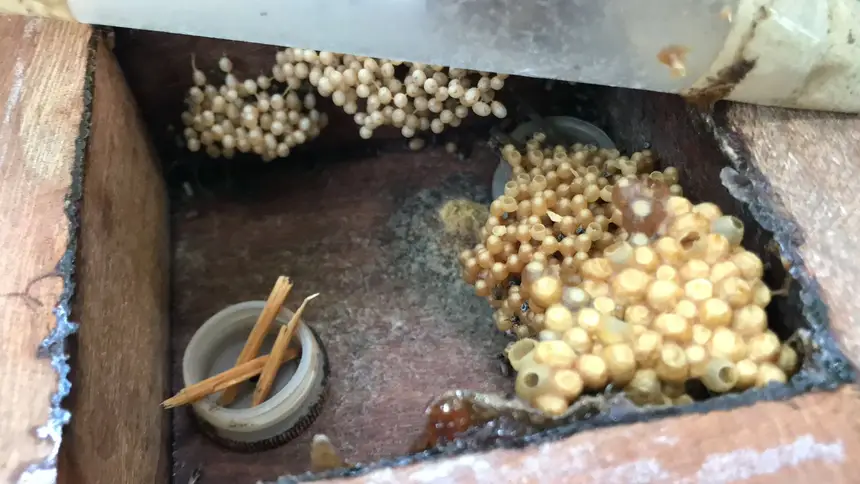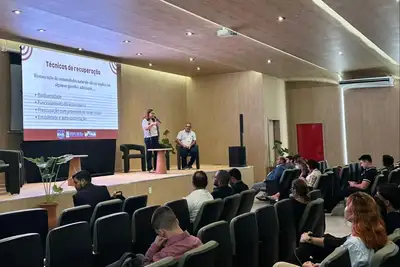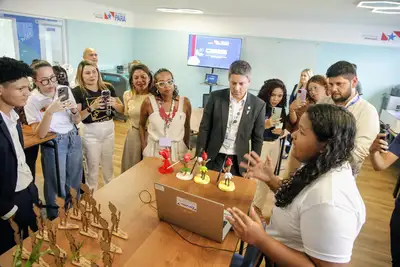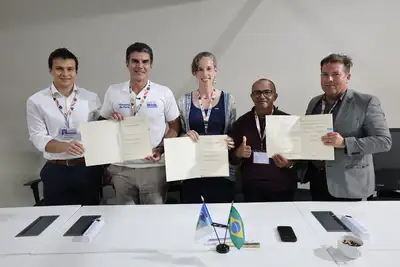In Pará, bees generate income, preserve the forest, and produce more than honey
The State government, through Sedap and Adepará, stimulates and develops the chain of meliponiculture and beekeeping. Last year, production exceeded an average of 700 tons of the product, generating R$ 16.24 million in revenue.
Despite being tiny in size, bees have a huge responsibility for the planet. Without them, food production in the world would certainly not exist. This Friday (3), National Bee Day is celebrated, a date created to mark the importance of this small animal that is so crucial for various activities, especially agriculture. Their work is responsible for the production of about 50 thousand tons of honey in the country. In Pará, last year, an average of 746 tons of the product was produced, generating a revenue of R$ 16.24 million.
Although they are inevitably associated with honey, bees produce propolis, royal jelly, pollen, among others. From their work, products such as soaps and even toothpaste are generated. Worldwide, there are more than 1,500 species, although the most well-known are the African ones (Apis). However, the main pollinators are the so-called stingless bees, whose breeding activity is called meliponiculture.
The activity is present in all regions of the State, according to monitoring by the Secretary of Agricultural Development and Fisheries (Sedap), which is finalizing the State Program for Sustainable Development of the Bee Production Chain in Pará (PróAbelhas), and also the regulation, through decree, of the Beekeeping Law (Law No. 7,055, of November 12, 2007), which establishes the State Policy for the Development and Expansion of Beekeeping. The monitoring of the management work of bees with and without stingers (native) is done by the Animal Production Coordination (Copan).
Geographical Indication - Pará is the first State in the country to have honey worked with Geographical Indication (GI), proving to be an important source of alternative income for producers in northeastern Pará, more precisely from the municipalities of São João de Pirabas and surrounding areas, such as Santarém Novo, Salinópolis, Quatipuru, and Primavera, in the northeastern region of Pará.
“Sedap is always seeking resources to further support the communities. In this appreciation of the bee producer, we are working on the GI of honey in São João de Pirabas and adjacent municipalities. A work that comes from another coordination in partnership with ours, so that the appreciation of these products is even greater,” explains the coordinator of Copan, agricultural technician Ândrio de Andrade.
The art of caring for bees - Just close to the capital of Pará, precisely 23 kilometers from the center of Belém, in the municipality of Ananindeua, it is possible to find a model property of about four hectares, where the activity of peri-urban meliponiculture is developed by producer Rubens Franco, who makes his passion for bees a source of income. The “nature assistant,” as he defines himself, says that since 2011 he has replaced his law practice with the art of caring for bees.
On the property, located in the transition area between the two municipalities, on Ricardo Borges Street, in the Guanabara neighborhood, he raises bees of the species Apis mellifera (with stingers) and stingless ones - uruçu-amarela, uruçu-cinzenta, and Trigona pallens, popularly known as “glass-eye,” canudo (Scaptotrigona postica) – which is the one that pollinates the flower of the açaí palm; the witch bee (from the ground) and the mosquito bee. There are 40 bee boxes distributed throughout the property.
With a specialization in Environmental Management, the meliponiculturist says that he not only has a passion for bees but for everything they represent in his life. He manages them and monitors the results. He states that the crowning achievement of his work is the production of honey. “This result shows that the surroundings and the environment where the bees are inserted are adequate,” he assures.
When he started, 12 years ago, Franco recalls, he only worked with the “uruçu-amarela” and, on a friend's recommendation, included other species on his property. More than a source of income, bees are, for him, part of life.
“Those who love bees love them, regardless of whether they produce honey or not. The bee is always present in my moments of happiness and also in sadness, which are fewer, but exist. When you open a box and feel the aroma, what a wonder. When you harvest the honey, you feel happy. It is significant,” he details.
In addition to focusing on bee breeding, Franco cultivates various fruit species and ornamental plants, as well as those that produce essences, such as vanilla. Among the fruit species are cupuaçu, pineapple, passion fruit, banana, cocoa, and açaí, whose pollination is done by the canudo and “glass-eye” species.
The meliponiculturist also explains that, in the different boxes where the bees work, they are divided according to species. “This year, as it is raining a lot, the flowering has not yet come. It may not come. But we should not be sad. We should be happy because the bees are alive and producing, not for us 100%, but for themselves, which will multiply,” he says.
One of the investments that the meliponiculturist makes in his work is regarding the use and division of the boxes where the bees work. According to him, there is a very large competition among them, and even the direction and positioning of the entrance have an influence. “I leave it more spaced out so they have more options to obtain floral resources, and the result is that we already have honey pots for them and for us, despite the rains. It is not good to have too many boxes on the property because otherwise, there is too much competition for food. Then they do not produce honey,” he detailed.
Despite working extensively with stingless bees, the breeder also works with Apis mellifera. Due to the location of the property, it is allowed to have up to three boxes, he informed.
One of the species that stands out on his property is the so-called “mosquito bee,” whose size reaches a maximum of 4 to 5 millimeters. “This bee is also part of the group of floral visitors of all plant species in our forest,” he explains. The tiny beings work in a mini box, which, according to Rubens Franco, measures 7 by 7, where a maximum of 200 individuals fit. “This is our dilemma as a bee breeder. To show people that it is not only the stinging bee that makes a difference. Those that have been adapted for millennia, like these here, or the canudo bee or the uruçu-amarela, visit our flowers and pollinate to produce food,” he concluded.
Valuing the activity - To stimulate the appreciation of the activity, especially in the Amazon, Sedap invests in actions to develop beekeeping (with stingers) and meliponiculture (without stingers). For the Secretary, it is important to show that behind the sociobiodiversity that makes up the Amazon biome is the work of bees, as highlighted by the animal production coordinator of the Secretary, Ândrio de Andrade.
During a recent visit to the property of meliponiculturist Rubens Franco, he highlighted the work done on site. “If only there were this initiative by other residents of the region, having bees in their backyards, both for managing and producing. To talk about bees, it is important to consider the people behind them, doing the work. It is necessary to understand the dynamics of each bee species and their biology, and we found that here,” Andrade observes.
The registration of bee breeders is done through the State Agency for Agricultural Defense of Pará (Adepará), being mandatory by the Ministry of Agriculture and Livestock (Mapa). Sedap, through Copan, responded to the request to mediate and organize with Adepará an action for the registration of bee breeders so that producers can formalize and access benefits, such as broader markets and obtaining quality certifications, in addition to strengthening the production chain and updating the sanitary registration. Among the municipalities visited, as Andrade recalls, were Acará (in the Tocantins Integration Region), Concórdia do Pará, and Tomé-Açu (in the Rio Capim Integration Region), with the participation of 30 bee breeders with and without stingers.
Adepará, in turn, works with the State Program for Bee Health (Pesab), whose objective is to support beekeeping and meliponiculture in the State of Pará, through activities related to Animal Health Defense, such as sanitary education, epidemiological investigation, diagnosis, monitoring, control, and prevention of pests and diseases. The goal is to keep the hives healthy, ensuring adequate production in quantity and quality of products, in addition to contributing to the pollination of orchards, essential for agriculture in Pará.
Some curiosities about bees - The coordinator of Copan, Ândrio de Andrade, specialized in the daily life of bees, highlights some curiosities about them. Bees provide a true example of organization. They strictly follow a rigid hierarchy of three social levels: the queen bee, drones, and workers, being therefore highly social, living in colonies.
A single honey bee (Apis mellifera) normally visits about 7,000 flowers per day, but 4 million visits are needed to produce one kilogram of honey.
The construction method of stingless bees is an example of sustainability: they recycle and reuse wax whenever possible, scraping wax remnants from other colonies to mix with their own.
Construction strategies: The structures built, such as brood combs (brood discs) and wax lamellae, are made to optimize space and protect the colony.
The construction of nests in tree hollows, on posts, or even externally shows adaptability and the use of varied resources from the environment.
Resource efficiency: The use of propolis, which combines wax and plant resins, allows bees to build resistant, waterproof structures with antimicrobial properties, without spending an excessive amount of pure wax, which has a higher production cost.


